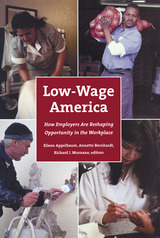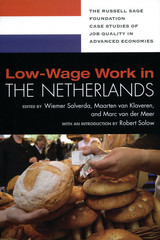143 books about Poverty & Homelessness and 9
start with L
143 books about Poverty & Homelessness and 9
143 books about Poverty & Homelessness
9 start with L start with L
9 start with L start with L

Laboring Below the Line
The New Ethnography of Poverty, Low-Wage Work, and Survival in the Global Economy
Frank Munger
Russell Sage Foundation, 2002
As the distribution of wealth between rich and poor in the United States grew more and more unequal over the past twenty years, this economic gap assumed a life of its own in the popular culture. The news and entertainment media increasingly portrayed the lives of the poor with such stereotypes as the lazy welfare mother and the thuggish teen, offering Americans few ways to learn how the "other half" really lives. Laboring Below the Line works to bridge this gap by synthesizing a wide range of qualitative scholarship on the working poor. The result is a coherent, nuanced portrait of how life is lived below the poverty line, and a compelling analysis of the systemic forces in which poverty is embedded, and through which it is perpetuated. Laboring Below the Line explores the role of interpretive research in understanding the causes and effects of poverty. Drawing on perspectives of the working poor, welfare recipients, and marginally employed men and women, the contributors—an interdisciplinary roster of ethnographers, oral historians, qualitative sociologists, and narrative analysts—dissect the life circumstances that affect the personal outlook, ability to work, and expectations for the future of these people. For example, Carol Stack views the work aspirations of an Oakland teenager for whom a job is important, even though it strains her academic performance. And Ruth Buchanan looks at low-wage telemarketing workers who are attempting to move up the economic ladder while balancing family, education, and other important commitments. What emerges is a compelling picture of low-wage workers—one that illustrates the precarious circumstances of individuals struggling with the economic conditions and institutions that surround them Each chapter also explores the capacity for economic survival from a different angle, with ancillary commentary complementing the ethnographies with perspectives from other fields of study, such as economics. At this moment of governmental retrenchment, ethnography's complex, nonstereotypical portraits of individual people fighting against poverty are especially important. Laboring Below the Line reveals the ambiguities of real lives, the potential for individuals to change in unexpected ways, and the even greater intricacy of the collective life of a community.
[more]

Legacies of the War on Poverty
Martha J. Bailey
Russell Sage Foundation, 2013
Many believe that the War on Poverty, launched by President Johnson in 1964, ended in failure. In 2010, the official poverty rate was 15 percent, almost as high as when the War on Poverty was declared. Historical and contemporary accounts often portray the War on Poverty as a costly experiment that created doubts about the ability of public policies to address complex social problems. Legacies of the War on Poverty, drawing from fifty years of empirical evidence, documents that this popular view is too negative. The volume offers a balanced assessment of the War on Poverty that highlights some remarkable policy successes and promises to shift the national conversation on poverty in America. Featuring contributions from leading poverty researchers, Legacies of the War on Poverty demonstrates that poverty and racial discrimination would likely have been much greater today if the War on Poverty had not been launched. Chloe Gibbs, Jens Ludwig, and Douglas Miller dispel the notion that the Head Start education program does not work. While its impact on children’s test scores fade, the program contributes to participants’ long-term educational achievement and, importantly, their earnings growth later in life. Elizabeth Cascio and Sarah Reber show that Title I legislation reduced the school funding gap between poorer and richer states and prompted Southern school districts to desegregate, increasing educational opportunity for African Americans. The volume also examines the significant consequences of income support, housing, and health care programs. Jane Waldfogel shows that without the era’s expansion of food stamps and other nutrition programs, the child poverty rate in 2010 would have been three percentage points higher. Kathleen McGarry examines the policies that contributed to a great success of the War on Poverty: the rapid decline in elderly poverty, which fell from 35 percent in 1959 to below 10 percent in 2010. Barbara Wolfe concludes that Medicaid and Community Health Centers contributed to large reductions in infant mortality and increased life expectancy. Katherine Swartz finds that Medicare and Medicaid increased access to health care among the elderly and reduced the risk that they could not afford care or that obtaining it would bankrupt them and their families. Legacies of the War on Poverty demonstrates that well-designed government programs can reduce poverty, racial discrimination, and material hardships. This insightful volume refutes pessimism about the effects of social policies and provides new lessons about what more can be done to improve the lives of the poor.
[more]

Lives on the Edge
Single Mothers and Their Children in the Other America
Valerie Polakow
University of Chicago Press, 1993
One out of five children, and one out of two single mothers, lives in destitution in America today. The feminization and "infantilization" of poverty have made the United States one of the most dangerous democracies for poor mothers and their children to inhabit. Why then, Valerie Polakow asks, is poverty seen as a private issue, and how can public policy fail to take responsibility for the consequences of our politics of distribution? Written by a committed child advocate, Lives on the Edge draws on social, historical, feminist, and public policy perspectives to develop an informed, wide-ranging critique of American educational and social policy. Stark, penetrating, and unflinching in its first-hand portraits of single mothers in America today, this work challenges basic myths about justice and democracy.
[more]

Low-Wage America
How Employers Are Reshaping Opportunity in the Workplace
Eileen Appelbaum
Russell Sage Foundation, 2003
About 27.5 million Americans—nearly 24 percent of the labor force—earn less than $8.70 an hour, not enough to keep a family of four out of poverty, even working full-time year-round. Job ladders for these workers have been dismantled, limiting their ability to get ahead in today's labor market. Low-Wage America is the most extensive study to date of how the choices employers make in response to economic globalization, industry deregulation, and advances in information technology affect the lives of tens of millions of workers at the bottom of the wage distribution. Based on data from hundreds of establishments in twenty-five industries—including manufacturing, telecommunications, hospitality, and health care—the case studies document how firms' responses to economic restructuring often results in harsh working conditions, reduced benefits, and fewer opportunities for advancement. For instance, increased pressure for profits in newly consolidated hotel chains has led to cost-cutting strategies such as requiring maids to increase the number of rooms they clean by 50 percent. Technological changes in the organization of call centers—the ultimate "disposable workplace"—have led to monitoring of operators' work performance, and eroded job ladders. Other chapters show how the temporary staffing industry has provided paths to better work for some, but to dead end jobs for many others; how new technology has reorganized work in the back offices of banks, raising skill requirements for workers; and how increased competition from abroad has forced U.S. manufacturers to cut costs by reducing wages and speeding production. Although employers' responses to economic pressures have had a generally negative effect on frontline workers, some employers manage to resist this trend and still compete successfully. The benefits to workers of multi-employer training consortia and the continuing relevance of unions offer important clues about what public policy can do to support the job prospects of this vast, but largely overlooked segment of the American workforce. Low-Wage America challenges us to a national self-examination about the nature of low-wage work in this country and asks whether we are willing to tolerate the profound social and economic consequences entailed by these jobs. A Volume in the Russell Sage Foundation Case Studies of Job Quality in Advanced Economies
[more]

Low-Wage Work in Denmark
Niels Westergaard-Nielsen
Russell Sage Foundation, 2008
The Danish economy offers a dose of American labor market flexibility inside a European welfare state. The Danish government allows employers a relatively high level of freedom to dismiss workers, but also provides generous unemployment insurance. Widespread union coverage and an active system of collective bargaining help regulate working conditions in the absence of strong government regulation. Denmark's rate of low-wage work—8.5 percent—is the lowest of the five countries under analysis. In Low-Wage Work in Denmark, a team of Danish researchers combines comprehensive national registry data with detailed case studies of five industries to explore why low-end jobs are so different in Denmark. Some jobs that are low-paying in the United States, including hotel maids and meat processors, though still demanding, are much more highly compensated in Denmark. And Danes, unlike American workers, do not stay in low-wage jobs for long. Many go on to higher paying jobs, while a significant minority ends up relying temporarily on income support and benefits sustained by one of the highest tax rates in the world. Low-Wage Work in Denmark provides an insightful look at the particularities of the Danish labor market and the lessons it holds for both the United States and the rest of Europe. A Volume in the Russell Sage Foundation Case Studies of Job Quality in Advanced Economies
[more]

Low-Wage Work in France
Eve Caroli
Russell Sage Foundation, 2008
In France, low wages have historically inspired tremendous political controversy. The social and political issues at stake center on integrating the working class into society and maintaining the stability of the republican regime. A variety of federal policies—including high minimum wages and strong employee protection—serve to ensure that the low-wage workforce stays relatively small. Low-Wage Work in France examines both the benefits and drawbacks of this politically inspired system of worker protection. France's high minimum wage, which is indexed not only to inflation but also to the average increase in employee wages, plays a critical role in limiting the development of low-paid work. Social welfare benefits and a mandatory thirty-five hour work week also make life easier for low-wage workers. Strong employee protection is a central characteristic of the French model, but high levels of protection for employees may also be one of the causes of France's chronically high rate of unemployment. The threat of long-term unemployment may, in turn, contribute to a persistent sense of insecurity among French workers. Low-Wage Work in France provides a lucid analysis of how a highly regulated labor market shapes the experiences of workers—for better and for worse. A Volume in the Russell Sage Foundation Case Studies of Job Quality in Advanced Economies
[more]

Low-Wage Work in Germany
Gerhard Bosch
Russell Sage Foundation, 2008
In recent years, the German government has intentionally expanded the low-wage work sector in an effort to reduce exceptionally high levels of unemployment. As a result, the share of the German workforce employed in low-paying jobs now rivals that of the United States. Low Wage Work in Germany examines both the federal policies and changing economic conditions that have driven this increase in low-wage work. The new "mini-job" reflects the federal government's attempt to make certain low-paying jobs attractive to both employers and employees. Employers pay a low flat rate for benefits, and employees, who work a limited number of hours per week, are exempt from social security and tax contributions. Other factors, including slow economic growth, a declining collective bargaining system, and the influx of foreign workers, also contribute to the growing incidence of low-wage work. Yet while both Germany and the United States have large shares of low-wage workers, German workers receive health insurance, four weeks of paid vacation, and generous old age support—benefits most low-wage workers in the United States can only dream of. The German experience offers an important opportunity to explore difficult trade-offs between unemployment and low-wage work. A Volume in the Russell Sage Foundation Case Studies of Job Quality in Advanced Economies
[more]

Low-Wage Work in the Netherlands
Weimer Salverda
Russell Sage Foundation, 2008
The Dutch economy has often been heralded for accomplishing solid employment growth within a generous welfare system. In recent years, the Netherlands has seen a rise in low-wage work and has maintained one of the lowest unemployment rates in the European Union. Low-Wage Work in the Netherlands narrows in on the causes and consequences of this new development. The authors find that the increase in low-wage work can be partly attributed to a steep rise in the number of part-time jobs and non-standard work contracts—46 percent of Dutch workers hold part-time jobs. The decline in full-time work has challenged historically powerful Dutch unions and has led to a slow but steady dismantling of many social insurance programs from 1979 onward. At the same time, there are hopeful lessons to be gleaned from the Dutch model: low-wage workers benefit from a well-developed system of income transfers, and many move on to higher paying jobs. Low-Wage Work in the Netherlands paints a nuanced picture of the Dutch economy by analyzing institutions that both support and challenge its low-wage workforce. A Volume in the Russell Sage Foundation Case Studies of Job Quality in Advanced Economies
[more]

Low-Wage Work in the United Kingdom
Caroline LLoyd
Russell Sage Foundation, 2008
The United Kingdom's labor market policies place it in a kind of institutional middle ground between the United States and continental Europe. Low pay grew sharply between the late 1970s and the mid-1990s, in large part due to the decline of unions and collective bargaining and the removal of protections for the low paid. The changes instituted by Tony Blair's New Labour government since 1997, including the introduction of the National Minimum Wage, halted the growth in low pay but have not reversed it. Low-Wage Work in the United Kingdom explains why the current level of low-paying work remains one of the highest in Europe. The authors argue that the failure to deal with low pay reflects a policy approach which stressed reducing poverty, but also centers on the importance of moving people off benefits and into work, even at low wages. The U.K. government has introduced a version of the U.S. welfare to work policies and continues to stress the importance of a highly flexible and competitive labor market. A central policy theme has been that education and training can empower people to both enter work and to move into better paying jobs. The case study research reveals the endemic nature of low paid work and the difficulties workers face in escaping from the bottom end of the jobs ladder. However, compared to the United States, low paid workers in the United Kingdom do benefit from in-work social security benefits, targeted predominately at those with children, and entitlements to non-pay benefits such as annual leave, maternity and sick pay, and crucially, access to state-funded health care. Low-Wage Work in the United Kingdom skillfully illustrates the way that the interactions between government policies, labor market institutions, and the economy have ensured that low pay remains a persistent problem within the United Kingdom. A Volume in the Russell Sage Foundation Case Studies of Job Quality in Advanced Economies
[more]
READERS
Browse our collection.
PUBLISHERS
See BiblioVault's publisher services.
STUDENT SERVICES
Files for college accessibility offices.
UChicago Accessibility Resources
home | accessibility | search | about | contact us
BiblioVault ® 2001 - 2024
The University of Chicago Press









